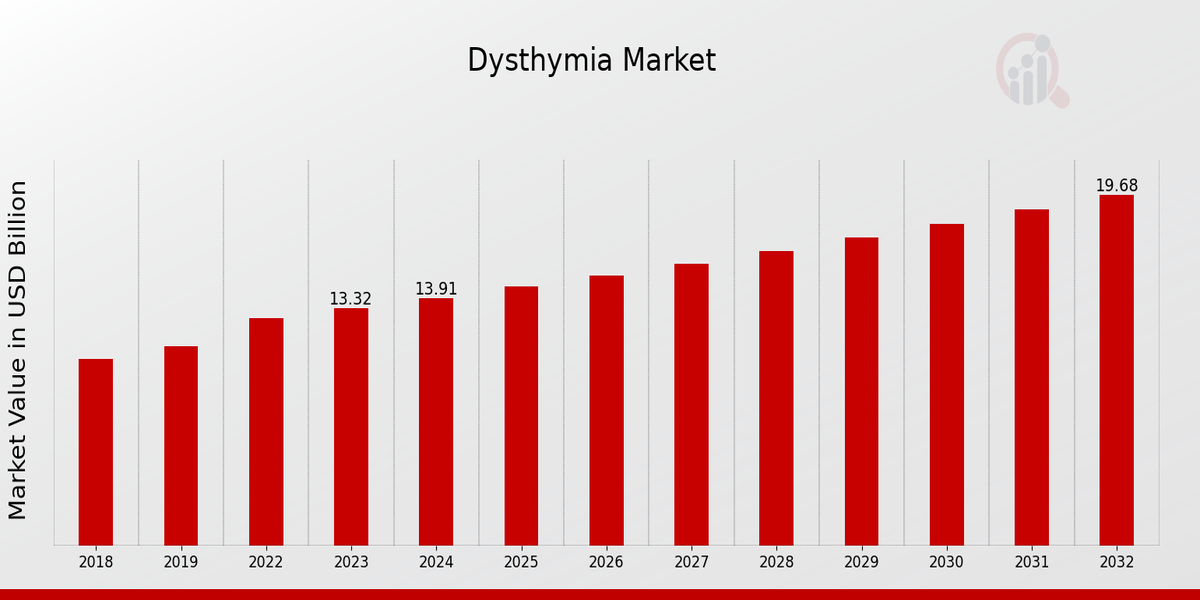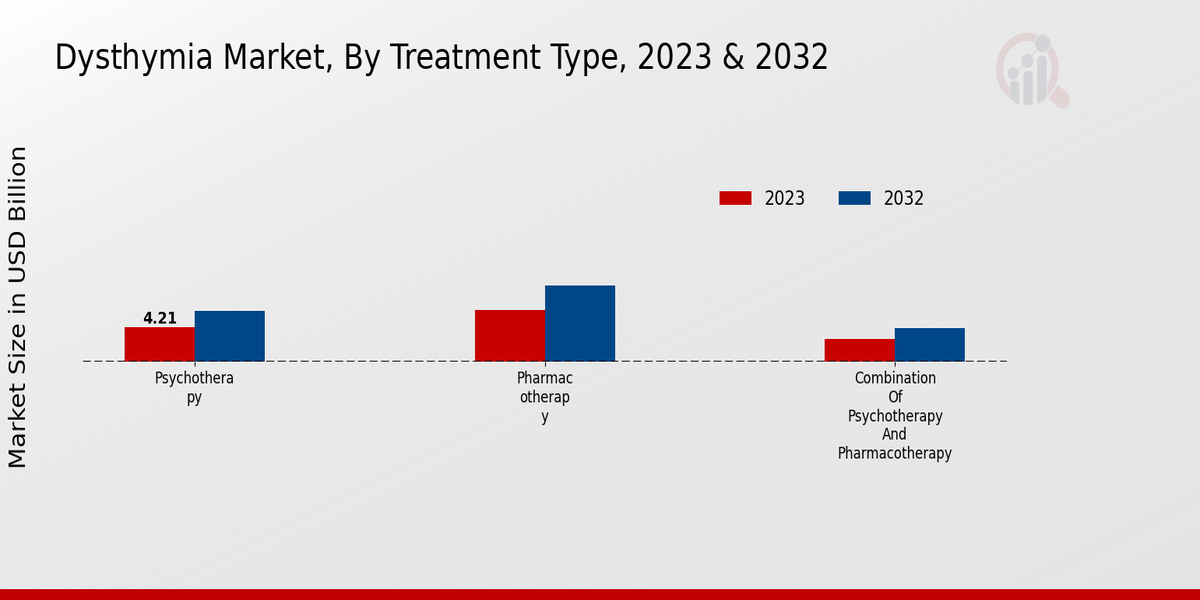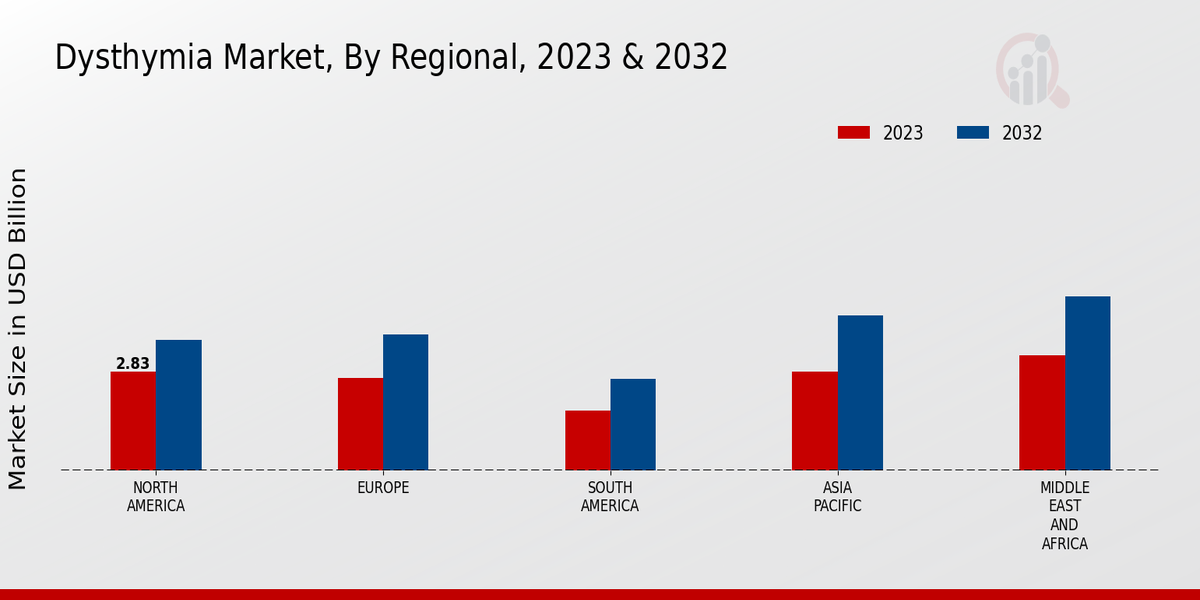Global Dysthymia Market Overview
As per MRFR analysis, the Dysthymia Market Size was estimated at 13.84 (USD Billion) in 2023. The Dysthymia Market Industry is expected to grow from 15.2 (USD Billion) in 2024 to 29.85 (USD Billion) by 2032. The Market CAGR (growth rate) is expected to be around 7.79% during the forecast period (2024 - 2032).
Key Dysthymia Market Trends Highlighted
Emerging therapeutic modalities, including the development of novel antidepressant drugs and non-invasive brain stimulation techniques, represent significant growth opportunities in the Dysthymia market. Additionally, the increasing availability of mental health services, both traditional and digital, is expected to fuel market expansion.Key market drivers include rising awareness of mental health conditions, particularly among younger populations, and the growing acceptance of seeking professional help for depression. The prevalence of chronic stress, sleep disturbances, and other factors contributing to dysthymia is also anticipated to drive market demand.Recent trends in the Dysthymia market include the integration of digital and technology-enabled solutions, such as online counselling platforms and mobile health applications, to improve access to care. The shift towards personalized medicine and the adoption of precision diagnostics are also expected to shape the future of the market, allowing for tailored treatment plans based on individual patient profiles and genetic predispositions.

Source: Primary Research, Secondary Research, MRFR Database and Analyst Review
Dysthymia Market Drivers
Rising Prevalence of Mental Health Disorders
Dysthymia is a chronic type of depression that is found to have a drastic effect on the severity of living. The globalization factor and the prevalence of mental health diseases, including both depression and anxiety, are the key factors contributing to the worldwide dysthymia market. The World Health Organization has published a report, stating that depression is the major cause of disability worldwide. To be more specific, over 264 million people suffer from the condition.It is worth adding that dysthymia is not as common as MDD. Estimation claims that it affects 1-2% of the entire population. In addition, the increase in mental health problems, recognition, diagnosis, awareness, and rising emphasis on removing the social stigma are the other contributors of worldwide dysthymia.
Increasing Demand for Novel Therapies
The development of novel therapies for dysthymia is another key market driver. Traditional treatments for dysthymia have often involved psychotherapy and antidepressant medications, but research is ongoing to explore new and more effective approaches. The advent of neuromodulation techniques, such as transcranial magnetic stimulation (TMS) and electroconvulsive therapy (ECT), has shown promise in treating treatment-resistant depression, including dysthymia.Additionally, the growing interest in personalized medicine and precision psychiatry is leading to the development of targeted therapies tailored to individual patient needs, further driving market growth in the dysthymia market.
Government Initiatives and Funding
Government initiatives and funding play a crucial role in supporting research and development in the dysthymia market. Recognizing the substantial burden of mental health disorders, governments worldwide are allocating funds to support research and development of new treatments and interventions. This funding helps accelerate the discovery and commercialization of novel therapies, contributing to the growth of the dysthymia market. Moreover, government initiatives aimed at raising awareness about mental health and reducing stigma encourage individuals to seek help and access appropriate care, further propelling market expansion.
Dysthymia Market Segment Insights
Dysthymia Market Treatment Type Insights
One of the ways the dysthymia market is segmented is by the type of treatment, which includes psychotherapy, pharmacotherapy, and a combination of psychotherapy and pharmacotherapy. Psychotherapy refers to talk therapy and cognitive-behavioral therapy through which the negative thought patterns and behaviors contributing to dysthymia can be identified and modified. On the other hand, pharmacotherapy uses drugs, such as selective serotonin reuptake inhibitors and serotonin-norepinephrine reuptake inhibitors, for regulating the balance of neurotransmitters in the brain.Meanwhile, the combination of psychotherapy and pharmacotherapy is the most effective procedure to follow within the treatment of dysthymia, as it allows addressing the psychological and biological properties of the disease. In 2023, the dysthymia market stood at USD 4.21 billion for Psychotherapy, showing that, by 2032, it will exceed USD 6.17 billion, which is equal to a 4.63% CAGR. The growth will be conditioned by the increasing mental disorder with a clinical psychologist in areas beyond hospitals. At the same time, the more familiarized population with the specifics of dysthymia and the more people who are willing to employ psychotherapy as the most viable and less harmful treatment options would define the increasing size of the respective market.The size of the dysthymia market is 6.34 billion USD for pharmacotherapy as of 2023, which will only increase by 2032 and amount to 9.31 billion USD at a 4.71% CAGR. The latter will occur due to the launch of innovative anti-depressants and the growing number of government initiatives aimed at promoting the affordability of mental care for the members of society. This rather fast growth of the respective market would also be conditioned by the active research and development within the domain of psychopharmacology, not in the least owing to peoples’ growing awareness about the risks of consuming medications of no or little use.As for the combination of psychotherapy and pharmacotherapy segment, it constituted the largest part of the Dysthymia Market as of 2023, having gained 2.77 billion USD in size. The growth of this market segment will only arise with time due to the continuation and expanding recognizability of the mentioned multifaceted approach.
Source: Primary Research, Secondary Research, MRFR Database and Analyst Review
Dysthymia Market Severity Insights
The dysthymia market is segmented by severity into mild, moderate, and severe. The moderate segment held the largest market share in 2023, accounting for over 45% of the market. The severe segment is expected to grow at the highest CAGR of 5.2% during the forecast period. This growth is attributed to the increasing prevalence of mental health disorders, including dysthymia, and the rising awareness of the condition. The mild segment is expected to witness a steady growth rate over the forecast period. The dysthymia market revenue is projected to reach USD 15.68 billion by 2026, registering a CAGR of 5.6% during the forecast period. The growth of the market is attributed to the increasing prevalence of mental health disorders, the rising awareness of dysthymia, and the development of new and effective treatments.
Dysthymia Market Comorbidities Insights
The dysthymia market is segmented by comorbidities into anxiety disorders, depression, and substance abuse. Among these, depression holds the largest market share, accounting for approximately 70% of the total market revenue in 2023. This dominance is attributed to the high prevalence of depressive symptoms in individuals with dysthymia, often leading to a dual diagnosis. Anxiety disorders, the second-largest segment, comprises conditions such as generalized anxiety disorder, panic disorder, and social anxiety disorder. These conditions frequently co-occur with dysthymia, contributing to a significant market share of around 20%.Substance abuse, the third segment, involves the misuse of substances like alcohol, drugs, and nicotine. It accounts for approximately 10% of the market share, as substance abuse is often a coping mechanism for individuals with dysthymia. This growth is driven by factors such as increasing awareness about mental health, rising prevalence of dysthymia, and the development of novel treatment approaches.
Dysthymia Market Regional Insights
The dysthymia market segmentation by region provides insights into the market's geographic landscape. North America holds a significant share of the market, driven by factors such as the high prevalence of mental health disorders and increased awareness about dysthymia. Europe follows closely, with a well-established healthcare system and a large population base. The APAC region is expected to witness significant growth in the coming years, owing to rising disposable income, increasing awareness, and improving healthcare infrastructure. South America and MEA are expected to contribute moderately to the overall market growth. These regional insights are crucial for businesses to tailor their strategies and target specific geographic markets effectively. 
Source: Primary Research, Secondary Research, MRFR Database and Analyst Review
Dysthymia Market Key Players and Competitive Insights
Leading players in the dysthymia market persistently focus on product innovation and development. The dysthymia market is expected to witness several alliances, legitimate agreements, and mergers and acquisitions, as leading players are aiming to expand their current portfolio and footprint. Major investors in the dysthymia market are significantly focusing on applying leading research and development efforts to come up with new products with more advanced features.The market’s growth is influenced by several factors such as increasing awareness on mental health, growing prevalence of depressive disorders, and expanding application of dysthymia treatment. Eli Lilly and Company is amongst the major investors in the dysthymia market. The company has developed a relatively strong presence in both the domestic and the dysthymia market. Several of its popular products such as Prozac fluoxetine and Cymbalta duloxetine belong to the class of antidepressants, widely used in treating dysthymia. The company already has a strong pipeline of products, and it is expected to introduce a few relatively new products over the next 3 years.Another notable player in the dysthymia market includes Pfizer. Both these companies are among the leading players in the Dysthymia Market. These companies have a relatively strong presence in the Dysthymia Market. They offer a wide range of antidepressants such as Zoloft sertraline and Effexor venlafaxine. Moreover, Pfizer and Eli Lilly and Company have strong financial resources, and they are expected to grow even further in these segments over the next few years.
Key Companies in the Dysthymia Market Include
-
Johnson & Johnson
-
BristolMyers Squibb Company
-
Forest Laboratories Inc.
-
Eli Lilly and Company
-
Merck & Co. Inc.
-
Novartis International AG
-
Teva Pharmaceutical Industries Ltd.
-
SanofiAventis U.S. LLC
-
Takeda Pharmaceutical Company Limited
-
GlaxoSmithKline plc
-
Pfizer Inc.
-
Sun Pharmaceutical Industries Ltd.
-
Shire Pharmaceuticals Group plc
-
Astellas Pharma Inc.
Dysthymia Market Developments
The dysthymia market is projected to reach USD 19.67 billion by 2032, exhibiting a CAGR of 4.43% during the forecast period (2024-2032). Rising prevalence of mental health disorders, increasing awareness about dysthymia, and growing demand for effective treatment options are major factors driving market growth. Technological advancements, such as the development of novel antidepressants and digital therapeutics, are further contributing to market expansion. Key players in the market include Eli Lilly, Pfizer, and Allergan. Recent developments include the approval of Spravato (esketamine) nasal spray by the FDA for treatment-resistant depression, including dysthymia.
Dysthymia Market Segmentation Insights
Dysthymia Market Treatment Type Outlook
Dysthymia Market Severity Outlook
Dysthymia Market Comorbidities Outlook
Dysthymia Market Regional Outlook
-
North America
-
Europe
-
South America
-
Asia Pacific
-
Middle East and Africa
| Report Attribute/Metric |
Details |
| Market Size 2023 |
13.84 (USD Billion) |
| Market Size 2024 |
15.2 (USD Billion) |
| Market Size 2032 |
29.85 (USD Billion) |
| Compound Annual Growth Rate (CAGR) |
7.79% (2024-2032) |
| Report Coverage |
Revenue Forecast, Competitive Landscape, Growth Factors, and Trends |
| Base Year |
2023 |
| Market Forecast Period |
2024-2032 |
| Historical Data |
2019-2023 |
| Market Forecast Units |
USD Billion |
| Key Companies Profiled |
Johnson & Johnson, BristolMyers Squibb Company, Forest Laboratories, Inc., Eli Lilly and Company, Merck & Co., Inc., Novartis International AG, Teva Pharmaceutical Industries Ltd., SanofiAventis U.S. LLC, Takeda Pharmaceutical Company Limited, GlaxoSmithKline plc, Pfizer Inc., Sun Pharmaceutical Industries Ltd., Shire Pharmaceuticals Group plc, Astellas Pharma Inc. |
| Segments Covered |
Treatment Type, Severity, Comorbidities, Region |
| Key Market Opportunities |
Rising Prevalence of Mental Health Disorders Increasing Availability of Innovative Treatments Growing Demand for Personalized Healthcare Technological Advancements in Diagnosis and Treatment Burgeoning Geriatric Population |
| Key Market Dynamics |
Increasing Prevalence Growing Awareness Novel Therapeutic Strategies Reimbursement Policies Technological Advancements |
| Countries Covered |
North America, Europe, APAC, South America, MEA |
Frequently Asked Questions (FAQ) :
The dysthymia market is estimated to be valued at USD 13.84 billion in 2023 and is projected to reach USD 29.85 billion by 2032, exhibiting a CAGR of 7.79% during the forecast period.
North America is expected to dominate the dysthymia market throughout the forecast period, owing to the high prevalence of mental health disorders and the presence of well-established healthcare infrastructure.
Rising awareness about mental health, increasing prevalence of dysthymia, and growing demand for effective treatments are the key factors driving the growth of the dysthymia market.
Dysthymia treatment is primarily used to manage symptoms such as persistent low mood, loss of interest, and fatigue.
Key competitors in the Dysthymia Market include Eli Lilly, Pfizer, GlaxoSmithKline, and Johnson & Johnson.
The dysthymia market is anticipated to register a CAGR of 7.79% from 2024 to 2032.
Lack of awareness, stigma associated with mental health, and limited access to healthcare services remain major challenges for the dysthymia market.
Advancements in research and development, growing awareness about mental health, and increasing government initiatives present significant growth opportunities for the dysthymia market.
The increasing adoption of telemedicine, personalized treatment approaches, and the development of novel therapies are key trends shaping the dysthymia market.
The COVID-19 pandemic has had a mixed impact on the dysthymia market, leading to increased demand for mental health services due to heightened stress and anxiety, but also disrupting supply chains and healthcare access.

















